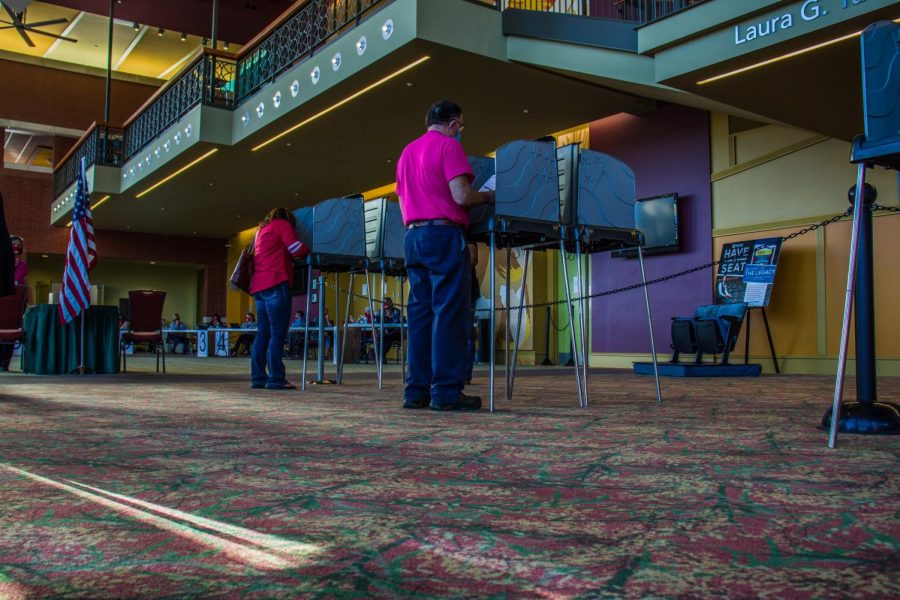Election 2020: Voter turnout record expected to break records
October 20, 2020
With Election Day coming up on Nov. 3, early voting underway and millions of mail-in ballots being processed right now, this election is likely to see unprecedented voter turnout.
“We expect 65-70% of the electorate to vote,” Saundra Ardrey, a political science professor at WKU who specializes in voting and electoral behavior, said.
Higher participation among the electorate usually means dissatisfaction with the status quo, Ardrey said.
“The electorate is a little bit more concerned, a little more upset about differ- ent issues,” Ardrey said. “That usually means they are not satisfied with the way things are going.”
According to a Gallup poll conducted in September, only 14% of the country is satisfied with the way things are going in the United States, nearly reaching the historic low of 7% satisfaction rate during the 2008 Recession.
Ardrey said this is a culmination of multiple different factors ranging from COVID-19, social injustice, economic stagnation and more. She says these factors will likely increase turnout among marginalized groups.
“You threaten the system when you have disaffected people who do not get immediate results,” Ardrey said.
Voter registration campaigns in-per- son and online, especially on social media, have increased voter registration numbers dramatically. For example, an Instagram post by Kylie Jenner with a link to vote.org increased website activity by 1,500% according to The Hill.
Other organizations like Bigtent Creative are also reaching younger voters through social media. A massive $350,000 campaign was implemented to register TikTok users who may have not normally voted. Bigtent registered over 21,000 voters according to Business Insider.
As of Oct. 10, one day after voting registration ended in Kentucky, the State Board of Elections reported 3,565,428 voters registered to vote in this upcoming election. This number is up from over 200,000 compared to 2016.
The Republican Secretary of State Michael Adams and the Democratic Governor Andy Beshear devised a bipartisan plan for how Kentucky is going to vote this year. The plan includes three weeks of early voting, absentee ballots for those with COVID-19 concerns and socially distanced voter booths on Election Day.
“It has never been easier to vote in Kentucky,” Ardrey said. “The County Clerk has already stated the amount of absentee ballots that have been requested is unprecedented.”
Ardrey doesn’t think that mail-in ballot rejection will be a problem in Kentucky.
“During the primary, we learned some valuable lessons of how to do these ballots, and the secretary of state and the governor have worked together to make it a little bit easier and less complicated,” Ardrey said.
Increased voter turnout typically favors Democrats, according to the New York Times, but even with increased voter registration and access in Kentucky, Ardrey said Democratic candidates like Amy McGrath and Joe Biden have an up- hill climb to make progress in Kentucky.
“I’m not too sure on how quickly Kentucky will turn blue or if it will turn blue,” Ardrey said.
Across the nation, however, Ardrey says we are seeing a political realignment with minority and disaffected Democratic voters.
“The Democratic party has to be careful because there’s a growing support by Gen Z African American voters and voters of color who are dissatisfied with the Democratic party,” Ardrey said. “Many of Gen Z and people of color are saying ‘We’ve been supporting the Democratic party and we’re still in trouble.’ They are really looking to the Republican party that is being led by our friend Kanye West that has given some legitimacy.”
Data from the 2016 election shows that about 8.4 million 2012 Obama voters backed Trump in 2016, when only 2.5 million Romney voters supported Clinton, according to the American National Election Studies. Most of these voters were concentrated in swing states, predominantly white and without a college degree, that Trump won, such as Michigan, Wisconsin and Pennsylvania.
Ardrey said it’s important for voters, especially voters of color, to be open to both parties in order to achieve substantial policy goals.
“If you’re giving an organization 90% of your vote, they don’t have to do very much for you, because if they got you, they ignore you,” Ardrey said. “And if you’re giving 90% to one group, then the other group ignores you also because they’re not going to get your vote. If we’re going to have [an] impact on policy, then we have to be willing to oscillate.”
Easton Reynolds can be reached at [email protected] Follow him on Twitter @epdogg5000.













